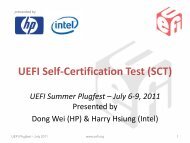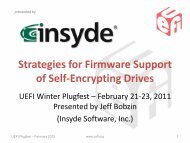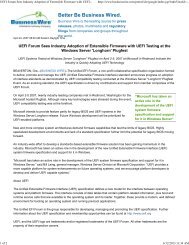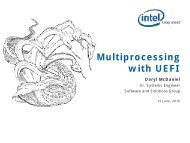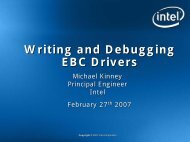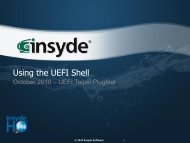AMD Common Silicon Firmware Module - UEFI
AMD Common Silicon Firmware Module - UEFI
AMD Common Silicon Firmware Module - UEFI
Create successful ePaper yourself
Turn your PDF publications into a flip-book with our unique Google optimized e-Paper software.
Why common firmware is important•Time to market– IBV and OEM/ODM can get the code at the same time to continue theirdevelopment and hence expedite the product completion•Ease of Porting– The standardizing the interface reduces or eliminates porting time– Hide the complexities associated with any new silicon features• Code Quality and Maintainability– Every silicon may bring newer method for initializing feature set– <strong>Common</strong> module hides the complexities behind standardized interface.– Fully validated code on <strong>AMD</strong> reference platform– Easy for debugging and post production support3September 27,2007<strong>AMD</strong> <strong>Common</strong> <strong>Silicon</strong> <strong>Firmware</strong> <strong>Module</strong>
<strong>AMD</strong> <strong>Silicon</strong> ComponentsThe <strong>Silicon</strong> components indicated here consists of• Processor Core Subsystem• Chipset4September 27,2007<strong>AMD</strong> <strong>Common</strong> <strong>Silicon</strong> <strong>Firmware</strong> <strong>Module</strong>
<strong>Common</strong> <strong>Firmware</strong> Interface(Processor)Processor CoreSubsystemProcessor PEIMProcessor DXEDriver(PPI)(PROTOCOL)PEIDXE<strong>UEFI</strong> PhaseDriver Binding andBoot ManagerSMMPlatform Initialization Phase5September 27,2007<strong>AMD</strong> <strong>Common</strong> <strong>Silicon</strong> <strong>Firmware</strong> <strong>Module</strong>
<strong>AMD</strong> Processor Core Subsystem<strong>AMD</strong> Processor core subsystem consist of followingcomponents-CPU Core-Hyper Transport-Memory Controller6September 27,2007<strong>AMD</strong> <strong>Common</strong> <strong>Silicon</strong> <strong>Firmware</strong> <strong>Module</strong>
Functionality of Processor CoreSubsystem• CPU Initialization– Sets up the Cache As RAM– Initializes CPU Core i.e. initializing BSP and APs.– APs remain in Halt State through out the POST unless it requiresany initialization– Create Processor specific information i.e.. <strong>AMD</strong> PowerNowinformation• Hyper Transport Initialization– Initializes the Coherent Links between Processors– Initializes the Non Coherent Links between Processor andChipsets(Cont.)7September 27,2007<strong>AMD</strong> <strong>Common</strong> <strong>Silicon</strong> <strong>Firmware</strong> <strong>Module</strong>
Functionality of Processor CoreSubsystem• Memory Controller Initialization– Performs Memory Controller Init– Performs DRAM Controller Init– Creates System Memory Map– Sets up the cacheability for system memory•8September 27,2007<strong>AMD</strong> <strong>Common</strong> <strong>Silicon</strong> <strong>Firmware</strong> <strong>Module</strong>
Calling Interface (Processor Core)• PEIM and DXE drivers call out to Agesa Ppi and AgesaProtocol depending on phase of execution to access theservices for Processor Subsystem<strong>UEFI</strong>PEIM/DXE drivers<strong>AMD</strong>ProcessorCorecode9September 27,2007<strong>AMD</strong> <strong>Common</strong> <strong>Silicon</strong> <strong>Firmware</strong> <strong>Module</strong>
Example of Calling Interfacetypedef struct _AGESA_PPI_PPI {CPU_INITIALIZE_RESET CpuInitializeReset;CPU_LOAD_UCODE CpuLoadUcode;CPU_VALIDATE_UCODE CpuValidateUcode;CPU_HT_INITIALIZE CpuHtInitialize;....} AGESA_PPI;10September 27,2007<strong>AMD</strong> <strong>Common</strong> <strong>Silicon</strong> <strong>Firmware</strong> <strong>Module</strong>
Example of Calling InterfaceEFI STATUS StatusAGESA_PPI *AgesaPpi;(*PeiServcies).LocatePpi (PeServices,..&AgesaPpiGuid,AgesaPpi);AgesaPpi->InitializeReset()11September 27,2007<strong>AMD</strong> <strong>Common</strong> <strong>Silicon</strong> <strong>Firmware</strong> <strong>Module</strong>
Example of Calling Interfacetypedef struct _AGESA_DXE_PROTOCOL {CPU_PSTATE_CREATE_ACPITABLES CpuPstateCreateAcpitables;CPU_PSTATE_GATHER_DATA CpuPstateGatherData;CPU_ACPI_SRAT CpuAcpiSrat;CPU_INITIALIZE_LATE CpuInitializeLate;..} AGESA_PROTOCOL;12September 27,2007<strong>AMD</strong> <strong>Common</strong> <strong>Silicon</strong> <strong>Firmware</strong> <strong>Module</strong>
Example of Calling InterfaceEFI STATUS StatusAGESA_PROTOCOL *AgesaProtocol;Status = gBS->LocateProtocol (&gAgesaDxeProtocolGuid, NULL,&AgesaDxeProtocolPtr);AgesaProtocol->CpuPstateCreateAcpitables ();13September 27,2007<strong>AMD</strong> <strong>Common</strong> <strong>Silicon</strong> <strong>Firmware</strong> <strong>Module</strong>
What does <strong>AMD</strong> deliver• <strong>AMD</strong> delivers the Processor Core Subsystem as AGESA. It alsosupplies the PEIM and DXE Drivers which produces AGESA Ppi andAGESA Protocol<strong>AMD</strong> ProcessorHTMemCPUAGESAAGESA Ppi/Protocol<strong>UEFI</strong> <strong>Firmware</strong>14September 27,2007<strong>AMD</strong> <strong>Common</strong> <strong>Silicon</strong> <strong>Firmware</strong> <strong>Module</strong>
What is “AGESA”A – <strong>AMD</strong> – Make it easy for customers to ship <strong>AMD</strong> processor based systems;reducing time, cost, trainingG – Generic – It works in any customer’s development environmentE – Encapsulated – OOP term meaning all knowledge about the processoris contained in this packageS – Software – applying software development methodologies to bemodular and maximize reusable codeA – Architecture – designed for the long term, spanning manyprocessor families and reducing customer changes15September 27,2007<strong>AMD</strong> <strong>Common</strong> <strong>Silicon</strong> <strong>Firmware</strong> <strong>Module</strong>
Components of AGESA• Hyper Transport Component– HT component initialization gets called out for each link.– There is a separate call out for Frequency and Width– Code is generic to support multi node and multi link– OEM Hooks are called before and after cHT and ncHTinitialization(Cont.)16September 27,2007<strong>AMD</strong> <strong>Common</strong> <strong>Silicon</strong> <strong>Firmware</strong> <strong>Module</strong>
Components of AGESA•CPU Components.– Provides services to be used by IBV through PPI and Protocols– Supports• Cache As Ram Initialization• CPUID• Platform Type (UMA, non UMA)• ACPI objects i.e. _PSS, _XPSS, _PST, _PSD• ACPI Tables• BrandID and MSR Initialization• Microcode Patch Loader• Processor Power State Information• SMM Initialization17September 27,2007<strong>AMD</strong> <strong>Common</strong> <strong>Silicon</strong> <strong>Firmware</strong> <strong>Module</strong>
Components of AGESA• Memory Controller– Handles memory initialization during normal POST and S3Resume– Provides single entry point for Memory Controller Init andDRAM Controller Init.– Callback to support• User configuration through NVRAM Read/Write• SPD Read• Setting of platform specific timing value.18September 27,2007<strong>AMD</strong> <strong>Common</strong> <strong>Silicon</strong> <strong>Firmware</strong> <strong>Module</strong>
AGESA Packaging• AGESA Package, currently contains source code forprocessor core subsystem and associated PPI andPROTOCOLS along with implemented PEIM and DXEDrivers (both DXE as well as SMM phase)19September 27,2007<strong>AMD</strong> <strong>Common</strong> <strong>Silicon</strong> <strong>Firmware</strong> <strong>Module</strong>
<strong>Common</strong> <strong>Firmware</strong> Interface (Chipset)ChipsetComponentChipset PEIM(PPI)Chipset DXE(PROTOCOL)SMMHandlerPEIDXE<strong>UEFI</strong> PhaseDriver Binding andBoot ManagerSMMPlatform Initialization Phase20September 27,2007<strong>AMD</strong> <strong>Common</strong> <strong>Silicon</strong> <strong>Firmware</strong> <strong>Module</strong>
Chipset Components• Chipset component is called CIM-x• The CIM-x components are distributed as– CIM-x NBB1 (Boot Block), NBB2 (Normal Boot)– CIM-x SBB1 (Boot Block), SBB2 (Normal Boot)• CIM-x NB and CIM-x SB are distributed independentlyto support system design based upon customersrequirement21September 27,2007<strong>AMD</strong> <strong>Common</strong> <strong>Silicon</strong> <strong>Firmware</strong> <strong>Module</strong>
CIM-x Enabling ModelSystem BIOSCIM-x <strong>Module</strong>CodeIBV CodeCIM-x PPI/ProtocolCIM-x CoreIn “C” codeLegacy WrapperLegacy BIOS22September 27,2007<strong>AMD</strong> <strong>Common</strong> <strong>Silicon</strong> <strong>Firmware</strong> <strong>Module</strong>
CIM-x Feature Summary• Same architecture for Northbridge and Southbridge• Most of the code written in C to support both the world i.e..<strong>UEFI</strong> and Legacy• IBVs calls CIM-x modules through Interface and Gate files inlegacy BIOS world.•<strong>UEFI</strong> BIOS uses PPI or PROTOCOL (<strong>UEFI</strong> interface) to executeCIM-x C files.• Interface available to support POST, Runtime, SMM andBootBlock for both the world•Brings consistency in providing solution to both the worldwithout compromising on quality.23September 27,2007<strong>AMD</strong> <strong>Common</strong> <strong>Silicon</strong> <strong>Firmware</strong> <strong>Module</strong>
CIM-x Model For <strong>UEFI</strong>• Core Code for CIM-x in “C”• PPI and PROTOCOL to access the core code• CIM-x PEIMs and Drivers provides access to CIM-x corecode for any PPI and DXE modules• Packaging scheme is common to both CIM-xNorthbridge and CIM-x Southbridge24September 27,2007<strong>AMD</strong> <strong>Common</strong> <strong>Silicon</strong> <strong>Firmware</strong> <strong>Module</strong>
Example of Calling Interface (CIM-xNorthbridge)typedef struct _PEI_<strong>AMD</strong>_NB_PPI {PEI_NB_POWERON_RESETPEI_NB_HT_INITNbPowerOnInit;NbHtInit;PEI_NB_PCIE_BASEADDRESS NbPcieBaseSet;} PEI_<strong>AMD</strong>_NB_PPI;extern EFI_GUID gPeiAmdNbPpiGuid;25September 27,2007<strong>AMD</strong> <strong>Common</strong> <strong>Silicon</strong> <strong>Firmware</strong> <strong>Module</strong>
Example of Calling Interface (CIM-xNorthbridge)EFI STATUS StatusPEI_<strong>AMD</strong>_NB_PPI *AmdNbPpi;(*PeiServcies).LocatePpi (PeServices,);..& gPeiAmdNbPpiGuid,&AmdNbPpiAmdNbPpi->NbPowerOnInit()26September 27,2007<strong>AMD</strong> <strong>Common</strong> <strong>Silicon</strong> <strong>Firmware</strong> <strong>Module</strong>
Example of Calling Interface (CIM-xNorthbridge)typedef struct _EFI_<strong>AMD</strong>_NB_CIM_X_PROTOCOL {NBCFGPWMCFGEFI_<strong>AMD</strong>_NB_INITEFI_<strong>AMD</strong>_NB_INITEFI_<strong>AMD</strong>_NB_INITEFI_<strong>AMD</strong>_NB_INITNbPolicy;PwmPolicy;NbInitPciEarly;NbInitEarlyPost;NbInitLatePost;NbInitPciELate;EFI_PCI_ROOT_BRIDGE_IO_PROTOCOL *PciRootBridgeIo;} EFI_<strong>AMD</strong>_NB_CIM_X_PROTOCOL;extern EFI_GUID gEfiAmdNbCimXProtocolGuid;;27September 27,2007<strong>AMD</strong> <strong>Common</strong> <strong>Silicon</strong> <strong>Firmware</strong> <strong>Module</strong>
Example of Calling Interface (CIM-xNorthbridge)EFI STATUS StatusEFI_<strong>AMD</strong>_NB_CIM_X_PROTOCOL *NbCimXProtocolPtr;Status = gBS->LocateProtocol (& gEfiAmdNbCimXProtocolGuid,NULL, &NbCimXProtocolPtr);NbCimXProtocolPtr->PciRoorBridgeIo ();28September 27,2007<strong>AMD</strong> <strong>Common</strong> <strong>Silicon</strong> <strong>Firmware</strong> <strong>Module</strong>
Example of Calling Interface (CIM-xSouthbridge)typedef struct _PEI_<strong>AMD</strong>_SB_PPI {PEI_SB_POWERON_RESETSbPowerOnInit;} PEI_<strong>AMD</strong>_SB_PPI;extern EFI_GUID gPeiAmdSbPpiGuid;29September 27,2007<strong>AMD</strong> <strong>Common</strong> <strong>Silicon</strong> <strong>Firmware</strong> <strong>Module</strong>
Example of Calling Interface (CIM-xSouthbridge)EFI STATUS StatusPEI_<strong>AMD</strong>_SB_PPI *AmdSbPpi;(*PeiServcies).LocatePpi (PeServices,);..& gPeiAmdSbPpiGuid,&AmdSbPpiAmdSbPpi->SbPowerOnInit()30September 27,2007<strong>AMD</strong> <strong>Common</strong> <strong>Silicon</strong> <strong>Firmware</strong> <strong>Module</strong>
Example of Calling Interface (CIM-xSouthbridge)typedef struct _EFI_<strong>AMD</strong>_SB_CIM_X_PROTOCOL {SBCFGEFI_<strong>AMD</strong>_SB_INITEFI_<strong>AMD</strong>_SB_INITEFI_<strong>AMD</strong>_SB_INITEFI_<strong>AMD</strong>_SB_INITEFI_<strong>AMD</strong>_SB_INITSbPolicy;BeforePciInit;AfterPciInit;LatePostInit;BeforePciRestoreInit;AfterPciRestoreInit;} EFI_<strong>AMD</strong>_NB_CIM_X_PROTOCOL;extern EFI_GUID gEfiAmdSbCimXProtocolGuid;;31September 27,2007<strong>AMD</strong> <strong>Common</strong> <strong>Silicon</strong> <strong>Firmware</strong> <strong>Module</strong>
Example of Calling Interface (CIM-xSouthbridge)EFI STATUS StatusEFI_<strong>AMD</strong>_SB_CIM_X_PROTOCOL *SbCimXProtocolPtr;Status = gBS->LocateProtocol (& gEfiAmdSbCimXProtocolGuid,NULL, &SbCimXProtocolPtr);SbCimXProtocolPtr->BeforePciInit ();32September 27,2007<strong>AMD</strong> <strong>Common</strong> <strong>Silicon</strong> <strong>Firmware</strong> <strong>Module</strong>
Summary• The Processor Core Subsystem code is available asAGESA• The chipsets (Northbridge and Southbridge) code isavailable as CIM-x• <strong>AMD</strong> Provides all the necessary infrastructure to enable<strong>UEFI</strong> on <strong>AMD</strong> <strong>Silicon</strong>In a nutshell………..<strong>AMD</strong> is committed to support <strong>UEFI</strong>33September 27,2007<strong>AMD</strong> <strong>Common</strong> <strong>Silicon</strong> <strong>Firmware</strong> <strong>Module</strong>
Questions and AnswersQ&A34September 27,2007<strong>AMD</strong> <strong>Common</strong> <strong>Silicon</strong> <strong>Firmware</strong> <strong>Module</strong>
Trademark Attribution<strong>AMD</strong>, the <strong>AMD</strong> Arrow logo and combinations thereof are trademarks of Advanced Micro Devices, Inc. in the United Statesand/or other jurisdictions. Other names used in this presentation are for identification purposes only and may be trademarksof their respective owners.©2006 Advanced Micro Devices, Inc. All rights reserved.35September 27,2007<strong>AMD</strong> <strong>Common</strong> <strong>Silicon</strong> <strong>Firmware</strong> <strong>Module</strong>



